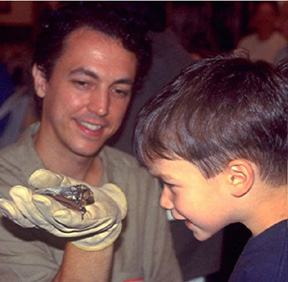
Articles
Characteristics
Conservation
Facts
Habitat
PHOTO GALLERY
Reproduction
Vampire Bats Conservation
Unfortunately for the vampire bats sake, it has a horrible reputation. People are filled with nightmares about these creatures, and the bats suffer because of it. Too many people seem to think that bats have no tangible economic or other value, and should not be protected.
Now however, efforts to save bats are slowly starting to develop. Now that more people are aware of the plight of bats, programs have been set in place to bring them back. These programs have given conservation-minded people hope that most species of bats can be saved. The U.S government, state wildlife departments, private conservation organizations, and many individuals across the country are now actively involved in bat conservation. The first step in this conservation process is to educate people about the role bats play in the environment.
Educational programs, designed to correct people’s misconceptions about bats, are beginning to produce positive results. Conservation projects, such as constructing gates at the entrance to caves to prevent people from entering them, are helping bats recover. The number of organizations, both governmental and private, committed to helping bats is growing each year. Without the involvement of these organizations and private individuals, bat populations would stand little chance of recovering.
The vampire bat itself is not a cause for concern, as there are many of them found throughout central and south America. Bats that make there home in the United States however, are a cause for concern. Despite the efforts to save them, many species of bats in America are continuing to decline in numbers!

International Bat Conservation
One organization solely focused on the conservation of bats, is bat Conservation International (BCI). In 1982, Merlin D Tuttle, a field biologist who had been studying bats since 1959, founded BCI. For severl years Tuttle had been increasingly concerned about the rapid decline in Bat populations around the world. It was obvious to him that the bats would continue to disappear until people were educated about the importance of the bats.
Providing educational materials about bats, therefore has been one of the primary functions of BCI. In its first year of existence BCI distributed a pamphlet entitled Bats and Public Health to state health departments around the country. This pamphlet helped to eliminate many misunderstandings abut bats and the “threat” they pose to humans. Each year since that time BCI has produced and distributed educational materials that have significantly increased peoples understanding of bats.
Working with local organizations, BCI has helped provide protective gates at more than a thousand cave entrances across the country. BCI works with local groups to encourage the use of bridges as roosting sites for the bats. This has become one of BCI’s most successful programs. They have also promoted bat conservation in many other countries around the world.